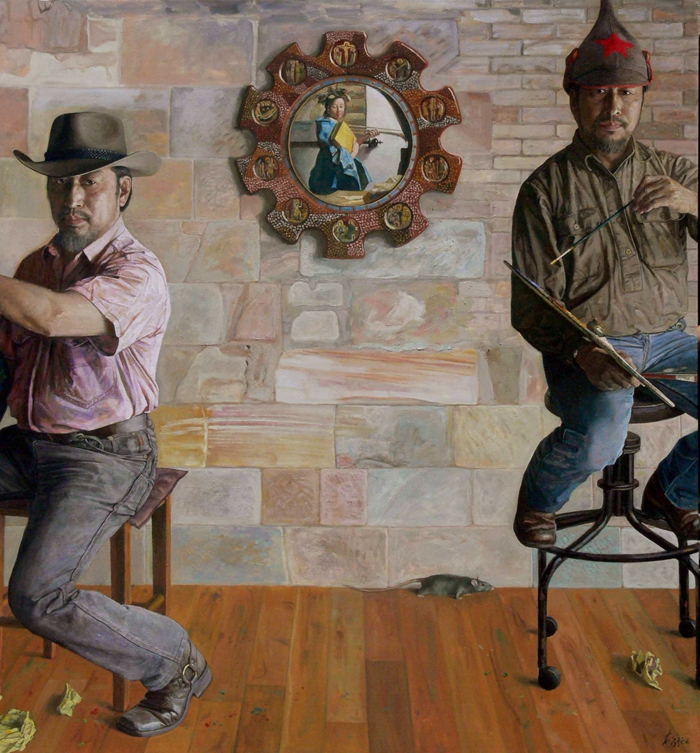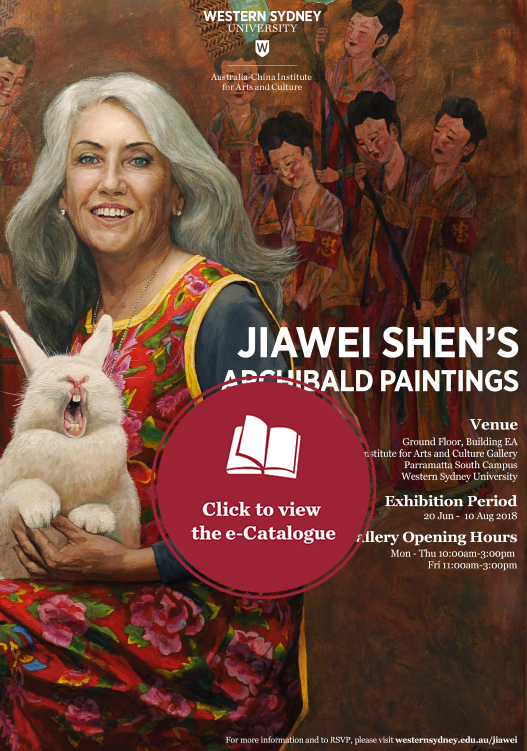Jiawei Shen's Archibald Paintings
Exhibition Details
Preview: 20 - 22 June 2018
Date: 23 June – 10 August 2018
Venue: Building EA.G.03, Australia-China Institute for Arts and Culture Gallery, Parramatta South Campus, Western Sydney University (Corner of James Ruse Drive and Victoria Road, Rydalmere)
Gallery Opening Hours: Monday – Thursday 10.00 am – 3.00 pm, Friday 11:00am - 3pm
Contact: Lindsay Liu, (02) 9685 9943
Exhibition Opening Event
Dates: 23 June 2018
Time: 4.00pm for 4.30pm
Venue: Foyer of Building EA, Australia-China Institute for Arts and Culture, Parramatta South Campus, Western Sydney University (Corner of James Ruse Drive and Victoria Road, Rydalmere)
Artist Statement
From 1990 to 2018, some twenty five China-born artists (not including Jenny Sages) became finalists for Australia’s prestigious Archibald Portrait Prize. Most of them came from mainland China in the 1980s and 1990s, although a few exceptions arrived after 2000. Many of them had had a specialist art school background in China, and some were finalists more than once. For this reason, the total number of finalist paintings by them was sixty four.
Jenny Sages as an artist from an earlier generation clearly does not belong to this Chinese group, because she was born in Shanghai in 1933, and left Shanghai in 1948, the year in which I was born in the same city, a few streets away from her home in the French Concession. In the Archibald competitions, she was twenty times a finalist, and seven times Highly Commended (runner-up).
I myself belong to the newer group of China-born Archibald finalists. I submitted my first entry work Mabel (1991) in 1992 but the work was not selected. In the following year I became a finalist and would continue to a finalist for seven years. Up until last year I was in the Archibald Portrait Prize twenty three times and fourteen times as finalist, including runner-up once in 1997. Up to now, thirteen of my twenty three Archibald works have been acquired by public or private collections. The rest of them remain with me in my own collection. In this exhibition I am showing eight from the twenty three and one of these is of course How to Explain Art With A White Rabbit (2015) which is in the collection of the White Rabbit Art Gallery. I thank Judith Neilson, its Subject and Owner, for kindly agreeing to loan it for this exhibition. The other seven are all in my own collection. Among these eight, three were Archibald finalists, and in the rest of the five, two, through some stroke of providence, won the Holding Redlich People’s Choice Award in the Salon des Refuses exhibition at the S.H.Ervin Gallery in 2003 and 2007.
I see myself as a natural portraitist. Because of the Archibald Prize which has been running for a century, I see Australia as my paradise and my lucky country, and I am pretty sure this country has inspired, and will continue to inspire, many other portrait artists in the world.
Jaiwei Shen沈嘉蔚
May 2018
Artist Biography
Jiawei Shen was born in Shanghai in 1948. Largely self-taught, he became a well-known artist in China in the mid-1970s during the Cultural Revolution. His oil painting Standing Guard for Our Great Motherland (1974) became an icon in those years and later shown in New York twice at Guggenheim Museum in 1998, and Asia Society Museum in 2008. In 2009 it was auctioned away in Beijing Guardian for the price of about one million US dollars. Now it is in the collection of the Long Museum in Shanghai.
From 1982 to 1984, he studied in the Central Academy of Fine Arts in Beijing, and later became a professional artist in Shenyang. He won the National Art Exhibition Prize in China five times.
Jiawei Shen moved to Australia in 1989 and for the first three years had to support himself financially by drawing portrait sketches for tourists at Darling Harbour. He looked on this experience as an opportunity to research portraiture and since then he has completed many accomplished portrait commissions in Australia and overseas. As a leading portraitist he was commissioned by the Australian government to paint official portraits for Pope Frances (2013), Princess Mary of Denmark (2005), Prime Minister John Howard (2009) and Australian Governor General Sir Peter Cosgrove (2018).
Since 1993, Jiawei Shen’s portrait paintings have been finalist for the Archibald Prize at the Art Gallery NSW fourteen times and in 1997 he was runner-up for this prize. He has also been a finalist in the Doug Moran Portrait Prize (1994, 1996, 2006,2007 and 2017) and has twice won third prize in the Sydney Royal Art Show (1993 and 1994). In 1995 he won the Mary McKillop Art Award and received a medal from Pope John Paul II. He also won the Sir John Sulman Prize in 2006, and the Gallipoli Art Prize in 2016.
Jiawei Shen has made a reputation for his large history paintings. In his Australian epic, At the Turn of Century (1998), there were more than 100 historical figures; in his Malaysian epic Merdeka (2008), 260; and in his Chinese epic Brothers and Sisters (2010-2017), more than 450.
Jiawei Shen has six works in the collections of the National Portrait Gallery and the Parliament House in Canberra. In China, he has seventeen works in the collections of the National Museum, the National Art Museum, and the National Military Museum in Beijing. His portrait of Pope Frances is in the Vatican Art Collection.
“Shen is a whole-hearted painter who has come through a tough artistic training in China. He has all the technical ability, the courage to take on ambitious compositions, and a hint of self-depreciating wit.” (John McDonald, SMH, 29/03/97).

